
Leeches in Medicine Page Selection Menu: 1 2 3 4 5 Next>>
Leeches in Medicine During the Golden Age of Piracy, Page 3
Leech Application
The applications of leeches to a patient involved specific procedures. First the leech had to properly selected and prepared - often being placed in leech containers or leech jars. Then the patient was prepared and the leech applied so that it could feed and remove the patient's blood. Finally, the leech was either removed or fell off after satiating itself and the bleeding from the wound needed to be stopped.
Leech Application: Choice and Preparation
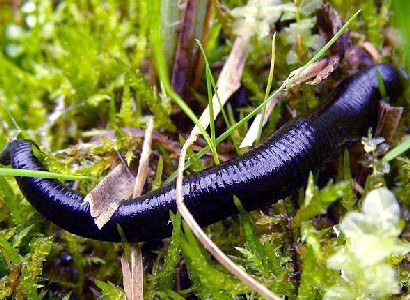
A bad leech? Photo: Manuel Krueger-KruschePierre Dionis warns that leeches "are of two sorts, the good and the venomous".1 He says that the venomous leeches "are in standing Waters, Ditches and Bogs: they are thick, they have a great Head, and the Back striped with blue; these we are to reject."2 In his 1810 book on the subject, James Rawlins Johnson explains that the ancient authors felt that leeches "are unfit for medical purposes when they are of a very red or black colour. If these, they say, should be unfortunately applied, they immediately give rise to Fever, Diarrhœa, and Syncope, and sometimes even produce inveterate ulcers." 3 When selecting a 'good' leech, the surgical authors agreed that the best sort have green backs sometimes with yellow stripes in them and reddish stomachs. They are also slender with small heads4 and "taken out of clear running Water."5 Johnson further adds that good leeches "should also have longitudinal lines on the back, and be taken from waters where there is an abundance of frogs."6
Pierre Dionis advises that leeches be allowed to "disgorge themselves in Water for some Days"7 after they have been retrieved. John Atkins says this is accomplished by keeping them "in large Glass Jars 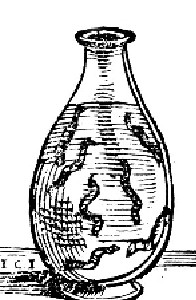
A simple leech jar taken from
Historia
Medica by W. van den Bossche (1638)
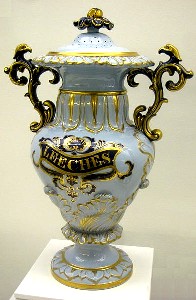
A fancy leech jar
full of Water, and [they should be] shifted every Day to purge well and be ready for use."8
The leech jar is one of those curios that certain modern day collectors have found appealing. The vary greatly in style from the very plain and simple glass jar seen in the 1638 drawing at left to the more ornate version seen at right. Use of leeches became very fashionable in the late 18th and early 19th centuries, which may explain the fascination with exotic-looking leech jars.
According to this page at the M.S. Rau Antiques website, " Authentic leech jars were most often made of glass, pottery or porcelain in the shape of an urn and possessed a turned lip to prevent the leeches from escaping. With exception of a few glass models, leech jars were fitted with lids outfitted with multiple air holes."9 In his book on surgical instruments, John Kirkup tells that pewter leech jars were also in use, explaining that "pewter manufacture achieved particular importance from the sixteenth to the nineteenth centuries".10
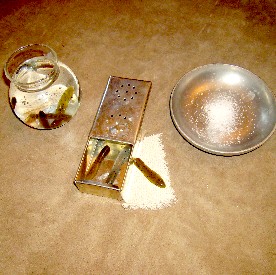
Mission's Leech Equipment. From left: a glass jar to
keep leeches, the box to shut them in, a leech on
the bit of linen for handling and salt for removal.
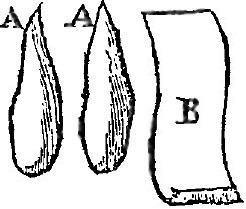
Leeches (A) and a Linen cloth (B) taken from
"A course of chirurgical operations"
by Pierre Dionis, p. 475
Dionis continues his description of preparing the leech for application in some detail. "When we would use them, we are to take them out of the Water, and shut them up close in some Box from the Evening before till the next Morning, or from Morning to the Evening, in order to render them the more hungry and more greedy of sucking."11
Dionis warns about a problem that may be encountered when preparing leeches which really must be reprinted here in full.
"When we apply the Leaches with our Fingers, they may chance to stick to them, or often will not bite, wherefore we are rather to hold them on a bit of Linen B, till they fasten on the Skin; We always use them the same way, and place a second, a third, and as many as are necessary."12
1 Pierre Dionis, A course of chirurgical operations: demonstrated in the royal garden at Paris. 2nd ed., p. 475; 2 Ibid., p. 476; 3 James Rawlins Johnson, A Treatise on the Medicinal Leech, London, p. 15; 4 John Atkins, The Navy Surgeon, p. 181, Dionis,p. 476, Johnson, p. 15; 5 Atkins, p. 181 6 Johnson, p. 15; 7 Dionis, p. 476; 8 Atkins, p. 182; 9 Collecting Medical Antiques - Leeching, ,M.S. Rau Antiques website, collected 5/15/12 10 John Kirkup, The Evolution of Surgical Instruments; An Illustrated History from Ancient Time to the Twentieth Century, p. 100-1 11 Dionis, p. 476; 12 Ibid.
Leech Application: Attachment and Use
As Dionis mentioned on the first page of this section, leeches were attached to places too sensitive for regular incision-style bleeding. Ambroise Paré suggests that they "bee put, as to the fundament, to open the coat of the hemorrhoid veins, to the mouth of the womb, the gums, lips, nose, fingers."1 John Atkins recommends that they be applied "according to the Complaint: In Distempers of the Head or Eyes, they are put on the Forehead; Temples, behind the Ears or Neck; in Tooth-achs, to the Gums; Peristernum in Diseases of the Breast; and Fundament in Hæmorrhoids; if Revulsion be designed, they should be set on the muscular Parts always; for near or on the Joints, the Parts are more exanguous [bloodless], and the Tendons laying superficially may incite more Pain."2

A woman applying leeches to herself, taken from
Historia
Medica by W. van den Bossche (1638)
When applying the leech, Atkins recommends the surgeon "Chaff the particular Parts [of the body] you set them on, and put the Leach on a clean Piece of Linnen towards it: If good, he soon takes, and if not may be invited by smearing a little Pidgeon's Blood [on the place where the leech is to be attached]."3 Note again the comment to handle the leeches with pieces of linen. Paré expands on the reasoning for this noting that if "Leeches bee handled with the bare hand, they are angred, and becom so stomachful, as that they will not bite; wherefore you shall hold them in a white and clean linnen cloth, and applie them to the skin, beeing first lightly scarified [having multiple small incisions made in the skin so that it bleeds], or besmeared with the blood of som other creature; for thus they will take hold of the flesh, together with the skin more greedily and fully."4
Paré adds a rather curious aside. "If you desire they should suck more blood then they are able to contain, cut off their tails as they suck, for thus they will make no end of sucking, for that it run's out as they suck it. The Leeches, by sucking, draw the blood not onely from the affected part whereto they are applied, but also from the adjacent and distant parts."5 Pierre Dionis gives further details, explaining that to keep a full leach going, you should "cut off their Tail with a Pair of Scissars, and from thence see all the Blood distill which fill'd them; so that they void by the Tail the Blood which they receive by their Trunk, like an Air Pump; and thus one of them alone will draw more Blood than six others, whose Tails are not cut off."6 Since leeches actually are taking the blood as food, this would be a certain death sentence for the little beastie. One can't help but feel at least a little sorry for the leech in this scenario.
1 Ambroise Paré, The Workes of that Famous Chirurgion Ambrose Parey, p.445; 2 John Atkins, The Navy Surgeon, p. 183; 3 Atkins, p. 182; ,4 Paré, p. 445; 5 Ibid.; 6 Pierre Dionis, A course of chirurgical operations: demonstrated in the royal garden at Paris. 2nd ed., p. 476

